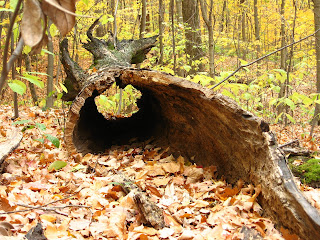 (Clay-covered clothes are the mark of a potter.)
(Clay-covered clothes are the mark of a potter.) First of all, the people are so nice. Peggy, the owner, and Rachel, my instructor, are both very helpful, of course, but even the other experienced potters who come in to work are always ready to give a newbie tips or advice. And, everyone is so kind. They never laugh at the sloppy, goofy looking things that the new students produce. When I threw a very irregular pot, Rachel said, "Symmetry is over-rated anyway." If a piece turns out with a big wobble in it, someone will tell you, "I like it. It's organic." And, when I goofed up what was supposed to be a mug, losing half of the clay and ending up with a tiny little pot, Peggy said, "You could put paper clips in it." Isn't that a positive thing to say?
Thursday night I had a practice session (we get one 2 hour class and one 2 hour practice each week) and I actually felt like I was getting it. In fact, I was quite proud of this creation, which I think will be a cereal bowl. (It didn't start out to be a cereal bowl, of course, but that is beside the point.)
Here is the main working room at Scarborough Fair. There are eight electric wheels, which are smaller than I expected them to be.


It was 25 lbs when I started, and I have used about 2/3 of it so far. You use a thin wire tool to cut off a section of clay, weigh it,
 and then wedge it. (Wedging is sort of like kneading, except that when you knead bread dough, you are putting air into it, and when you wedge clay, you are working the air bubbles out of it.) The clay is then placed on a bat, which sits on top of the wheel, is centered, hollowed out and pulled up into whatever shape the potter desires (or, in my case, whatever shape it happens to take.)
and then wedge it. (Wedging is sort of like kneading, except that when you knead bread dough, you are putting air into it, and when you wedge clay, you are working the air bubbles out of it.) The clay is then placed on a bat, which sits on top of the wheel, is centered, hollowed out and pulled up into whatever shape the potter desires (or, in my case, whatever shape it happens to take.)Here is Carol, one of the experienced potters, working at a wheel. This process is calling "pulling" the clay.

These are the other two pieces I made Thursday night. This was just supposed to be practice making a straight sided cylinder. I think it will probably become another mug.

This piece was going to be a short, wide vase, but it sort of got screwed up. Now, I think I might put a handle on it and make it into a basket. Or, maybe it is a candy dish. See the wobble in the right side? That's organic!

And here are some of the creations which have been fired and are awaiting pick-up by their owners. (None of these are mine.)

These are my first, pitiful little projects - two mugs, a paper clip holder, and two "salsa bowls." (Apparently at Scarborough Fair, anything which is not immediately identifiable is a salsa bowl.) These pieces have been bisque-fired, the first of two passes through the kiln, and are waiting to be glazed, which we will learn in our last week of class.

This is my "lidded vessel." Lids are hard. After you make the container, you have to make a lid that fits it. At first, the edge of this lid was nice and round and symmetrical, but it was too big. When I tried to trim it down to make it more balanced, I was in too big of a hurry and took too much clay off too fast, leaving me with a jagged edge. I never could make it round again. This pot is "leather hard" and has to dry to the "bone hard" stage before it can be fired for the first time.

Potters, working, talking, laughing. This is a happy, friendly group of women. From the right, Ginger (standing,) Carol, Peggy, and ?? (I forget her name.)

Is it any wonder I am having such fun? Next update when I have done some glazing!















































